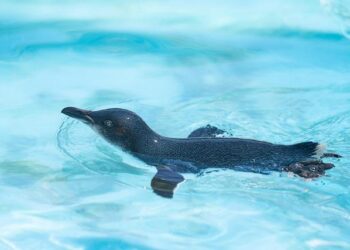The newly-discovered Late Triassic bone bed at Lavernock, South Wales, represents a storm deposit that preserves a rich coastal marine assemblage with a diverse array of fish and marine reptiles.

View of the cliff face at Lavernock Point from the east end of the beach, showing the red mudstones of the Williton Member (Mercia Mudstone Formation) transitioning upwards into the interbedded shales of the Westbury Formation. Image credit: Evans et al., doi: 10.1016/j.pgeola.2024.05.001.
“The newly-discovered bone bed paints the picture of a tropical archipelago, which was subjected to frequent storms, that washed material from around the surrounding area, both in land and out at sea, into a tidal zone,” said Owain Evans, a paleontologist at the University of Bristol.
“This means that from just one fossil horizon, we can reconstruct a complex ecological system, with a diverse array of marine reptiles like ichthyosaurs, plesiosaurs and placodonts in the water, and dinosaurs on land.”
The discovery was made at Lavernock Point, close to Cardiff and Penarth in South Wales, where the cliffs of dark-colored shales and limestones document ancient shallow seas.
At several levels, there are accumulations of bones, including the remains of fish, sharks, marine reptiles and occasionally, dinosaurs.
“I had visited the coast at Penarth all my life, growing up in Cardiff, but never noticed the fossils,” Evans said.
“Then, the more I read, the more amazing it became.”
“Local geologists had been collecting bones since the 1870s, and most of these are in the National Museum of Wales in Cardiff.”
“The collections from Lavernock go all the way back to the 19th century, with many sections of the bone bed being collected over the years,” said Dr. Cindy Howells, curator of paleontology at the National Museum of Wales.
“The presence of dinosaur fossils at the site ensures that it remains one of the most significant localities for paleontology in Wales.”
The paleontologists also unearthed the fossilized remains of a placodont osteoderm, and a single coelacanth gular bone.
“The remains of coelacanths and placodonts are relatively rare in the UK, which makes these finds even more remarkable,” said Dr. Chris Duffin, a paleontologist at the University of Bristol and the Natural History Museum in London.
“These two fossils alone help build a broader picture of what the Rhaetian in the UK would have looked like.”
“The volume of dinosaur remains found at Lavernock is extremely exciting, and is a chance to study a complex, and often mysterious period in their evolutionary history,” said University of Bristol’s Professor Michael Benton.
“We have identified the remains of a large Plateosaurus like animal, along with several bones which likely belonged to a predatory theropod.”
The findings appear in the Proceedings of the Geologists’ Association.
_____
Owain Evans et al. Microvertebrates from the basal Rhaetian Bone Bed (Late Triassic) at Lavernock, South Wales. Proceedings of the Geologists’ Association, published online May 23, 2024; doi: 10.1016/j.pgeola.2024.05.001
>>> Read full article>>>
Copyright for syndicated content belongs to the linked Source : Breaking Science News – https://www.sci.news/paleontology/lavernock-bone-bed-dinosaurs-wales-12978.html































